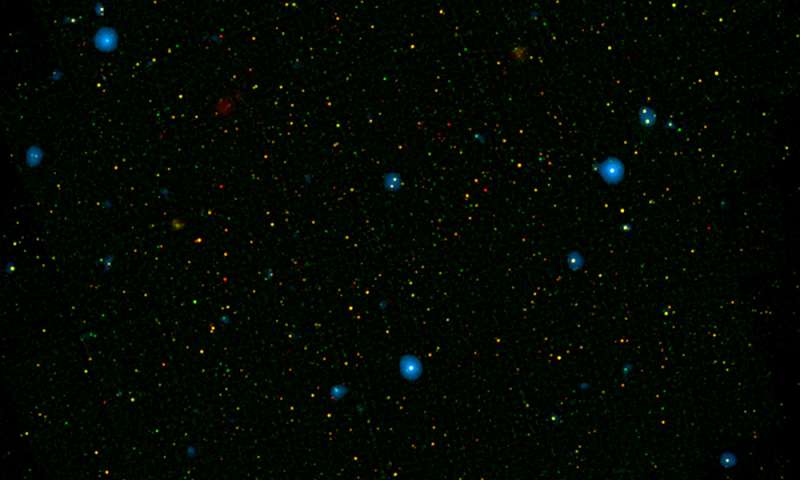For the first time ever, NASA’s Chandra mission has pinpointed large numbers of black holes that send out high-energy X-rays. Although these unique black holes possess the highest pitched “voices” compared to their lower energy counterparts, until now they have remained elusive.

The blue dots in the above picture represent galaxies that contain supermassive black holes emitting high-energy X-rays. Credit: NASA/JPL-Caltech
Prior to the current findings, NASA’s Chandra mission has been able to determine many of the black holes that contribute to the X-ray background, but not those that release high-energy X-rays.
The discovery of a large number of black holes that release these high-energy X-rays brings scientists closer to understanding the high-energy X-ray background created by the cosmic choir of black holes in space with the highest voices.
“We’ve gone from resolving just two percent of the high-energy X-ray background to 35 percent,” said Fiona Harrison of Caltech and lead author the upcoming new study describing the findings. “We can see the most obscured black holes, hidden in thick gas and dust.”
Understanding the X-ray background is essential to shed light on the growth patterns of supermassive black holes and the galaxies that they lie in. High-energy X-rays in particular reveal what lies around obscured supermassive black holes that are otherwise difficult to observe and can help determine the distribution of gas and dust that feed and hide these phenomena.
The NuSTAR telescope is the first to be capable of capturing high-energy X-rays into clear pictures and will no doubt be integral in building a more comprehensive picture of the X-ray background using data from these hidden high-energy black holes.
“Before NuSTAR, the X-ray background in high-energies was just one blur with no resolved sources,” Harrison said. “To untangle what’s going on, you have to pinpoint and count up the individual sources of the X-rays.”
“We knew this cosmic choir had a strong high-pitched component, but we still don’t know if it comes from a lot of smaller, quiet singers, or a few with loud voices,” said Daniel Stern of NASA’s Jet Propulsion Laboratory and co-author of the study. “Now, thanks to NuSTAR, we’re gaining a better understanding of the black holes and starting to address these questions.”
The findings will be published in an upcoming issue of The Astrophysical Journal. The data can currently be viewed on the pre-print server arXiv.org.









